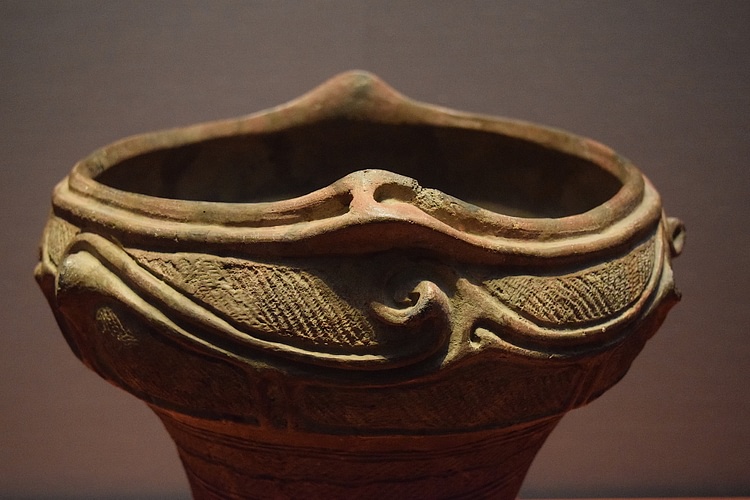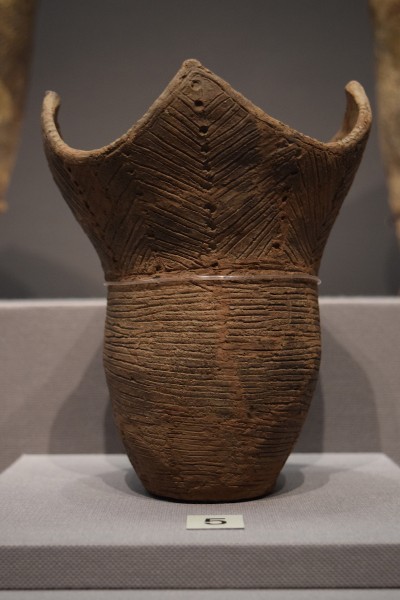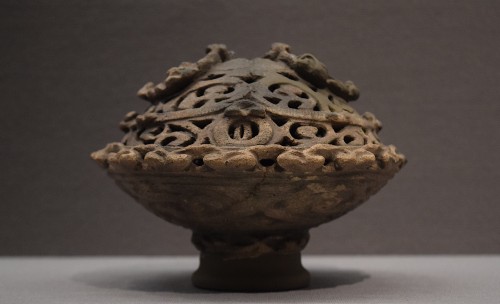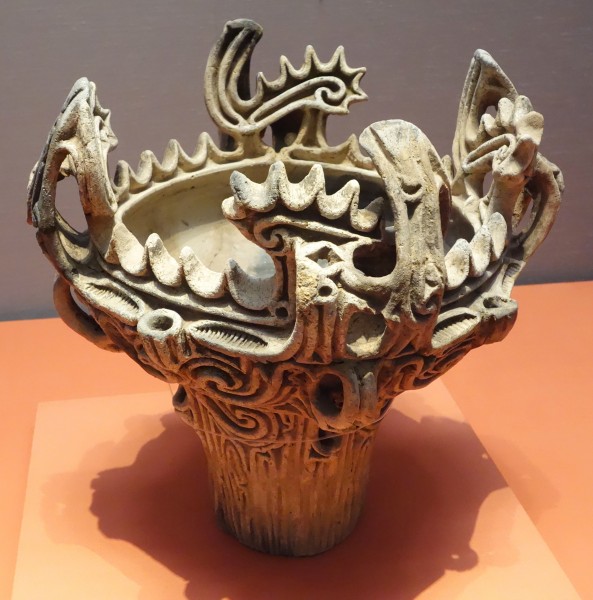Jomon Pottery › Ninigi » Ancient origins
Articles and Definitions › Contents
- Jomon Pottery › Ancient History
- Ninigi › Who Was
Ancient civilizations › Historical and archaeological sites
Jomon Pottery › Ancient History
Definition and Origins

The Jomon Period (c. 14,500 - c. 300 BCE) of ancient Japan produced a distinctive pottery which distinguishes it from the earlier Paleolithic Age. Jomon pottery vessels are the oldest in the world and their impressed decoration, which resembles rope, is the origin of the word jomon, meaning 'cord pattern'.
Jomon pottery, in the form of simple vessels, was first produced c. 13,000 BCE around Shinonouchi in Nagano, making them the oldest such examples in the world. Another early production site was Odai-Yamamoto in Aomori. Jomon pottery figurines are rather later, the oldest known example being the 'Jomon Venus ' which dates to c. 5000 BCE. Two general types of pottery were produced: a dark grey kind with angular edges, curved line decoration and handles which are often shaped to resemble animal heads or vessels with a reddish colour and either no decoration at all or a few wavy or zigzag lines.
Potters were likely semi-specialists only dedicating some of their time to pottery manufacture. As kilns have not been excavated from the period it is thought that vessels were fired in open fires. There is evidence of exchange of locally produced pottery between different communities, but as such vessels are very similar, the exchange was likely of the goods stored within the vessels themselves.

Jomon Vase
FORMS
Six categories of vessel shape have been identified by Japanese scholars of Jomon pottery:
- fukabachi - deep bowls (the most common type) and jars with a wide mouth, sometimes with a contracted neck.
- asabachi - shallow bowls.
- hachi - bowls of medium depth.
- sara - bowls so shallow they resemble plates.
- tsubo - vessels with a narrow mouth, sometimes with a long neck.
- chuko - vessels with spouts.

Jomon Spouted Vessel
Most vessels have either a flat or rounded bottom, but later examples are predominantly made with a flat base. In addition to these broad groups are vessels which resemble lamps or incense burners which have apertures as part of the decoration and figurines. By the end of the period, there are two distinct groups into which all vessels can be categorised: plain rough wares with very little decoration (a rope impress) and fine wares with more varied decoration. Traces of fire damage and greater wear and tear indicate that rougher wares were for daily use while finer vessels, usually undamaged, were reserved for ritual use only.

Jomon Incense Burner
DECORATION
Many vessels, then, are plain, but around half have decoration of some kind, most typically lines and waves made by impressing a cord onto the wet clay before firing, hence the name jomon or 'cord pattern' for the pottery and time period of this era of Japanese history. There are some regional differences and scholars identify, in particular, chinsen - mon in the east of Japan where shells were used to incise the clay and oshigata - mon in the west where impressions were made with a dowel.Decoration becomes markedly more extravagant in the middle of the period with the so-called 'fire-flame' type (aka UmatakaKaen ) from the Hokuriku region, and especially the Sasayama site in the Niigata Prefecture, where vessels are covered in applied thin rolls of clay to form lines, swirls, and crests. Towards the end of the period decoration is again minimised and in some regions disappears altogether.

Jomon 'fire-flame' Vessel
EVOLUTION
When migrants from the Asian continent began to arrive in Japan from around 400 BCE (or even earlier), they brought with them new pottery techniques, forms, and decoration. It is interesting to note that this expansion of ideas from abroad is evidenced in western Japan then displaying a much greater variation in pottery manufacture than the eastern side of the islands. The fashion for minimal decoration became widespread in western Japan, as did a distinction between glazed and unglazed wares. Jomon pottery was, consequently, gradually replaced by the finer pottery of the Yayoi Period (c. 300 BCE - c. 250 CE) which has no decoration and a reddish colour. These wares would be replaced in turn by the higher quality Sue stoneware which was introduced from Korea in the Kofun Period (c. 250 CE - 538 CE).
[sasakawa]
Ninigi › Who Was
Definition and Origins

Ninigi -no-Mikoto, or simply Ninigi, is the grandson of the supreme Shinto deity Amaterasu, the sun goddess. He is the son of Ama-no-Oshiho-mimi and, descending to earth as the first just ruler, he brought with him gifts from Amaterasu as symbols of his authority which remain part of the Japanese imperial regalia today. Ninigi became the great-grandfather of Japan ’s first emperor, the semi-legendary Emperor Jimmu, and so established a divine link between all subsequent emperors and the gods.
NINIGI DESCENDS FROM THE HEAVENS
In Japanese mythology, the sun goddess Amaterasu Omikami asked her son Ama-no-Oshiho-mimi to descend from the heavens to rule the world of the mortals. Twice refusing this honour after seeing the general chaos that prevailed in the world, Ama-no-Oshiho-mimi nominated his son Ninigi-no-Mikoto (full name: Ame-Nigishi-Kuninigishi-Amatsu-hiko-no-ninigi-no-mikoto) to go in his place. To this Amaterasu finally agreed, and she gave Ningi three gifts to help him on his way. These were the Yasakani, a fabulous jewel (or pearls or magatama beads), source of the ancient quarrel between Amaterasu and her brother Susanoo, the storm god; the Yata, the mirror which had been made by the gods and successfully used to tempt Amaterasu out of the cave which she hid in following some typical bad behaviour from Susanoo; and Kusanagi, the great sword Susanoo had plucked from a monster's tail. These would become the three emblems of Ninigi's power ( sanshu no jingi), and they became the imperial regalia of his descendants, the emperors of Japan, starting with his great-grandson Emperor Jimmu (r. 660-585 BCE). Thus, all subsequent emperors were able to claim a direct descent from the gods and so legitimise their authority to rule Japan.
The celebrated 7th-century CE poet Kakinomoto Hitomaro composed this poem on Ninigi's descent to govern humanity:
At the beginning of heaven and earthThe eight hundred, the thousand myriads of godsAssembled in high councilOn the shining beach of the Heavenly River,Consigned the Government of the HeavensUnto the Goddess Hirume [Amaterasu], the Heaven-Illuminating One,And the government for all time,As long as heaven and earth endured,Of the Rice-abounding Land of Reed PlainsUnto her divine offspring,Who, parting the eightfold clouds of the sky,Made his godly descent upon the earth.Manyoshi (Keene, 104-105)
Amaterasu also gave Ninigi some specific instructions regarding the Yata mirror: "Consider this mirror as thou wast wont to consider my soul, and honour it as myself" (Hackin, 395). Eventually, the mirror would indeed become an object of worship or shintai and end up in the Ise Grand Shrine in the Mie Prefecture, dedicated to Amaterasu and still today Japan's most important Shinto shrine.

Naiku, Ise Grand shrine
Ninigi, carrying his three precious goods, and accompanied by three gods (including Ame-no-uzume, the dawn goddess, and Sarutahiko-no- kami, the god of crossroads) and five chiefs, landed on earth at the top of Mt. Takachiho, in the south of Kyushu. From there, after first building himself a palace, he went to the temple of Kasasa in Satsuma province where the five chiefs set about laying down the principles of the Shinto religion, creating a priesthood and organising the building of temples. The chiefs would pacify the land and establish the clans which would dominate Japanese government for centuries to come such as the Fujiwara clan. In this capacity, the five became the ancestral deities of these clans, the ujigami.
NINIGI ESTABLISHED THE IMPERIAL LINE OF THE JAPANESE THRONE, THE FIRST EMPEROR JIMMU BEING HIS GREAT-GRANDSON.
NINIGI & SAKUYA-HIME
Ninigi quickly found romance on earth when he bumped into the girl Sakuya-hime, and he immediately proposed marriage.The girl faltered, telling Ninigi she first had to have permission from her father. The god obliged and went to the girl's home nearby. The father (who in some versions is the mountain god Oyamatsumi-no-kami) gave a rather cryptic response to Ninigi's request and offered him the choice of his two daughters or both. The other girl, Iwanaga-hime, was not quite the stunner her younger sister was, and so Ninigi stuck with his first choice. The father, angered that he had chosen the weaker of his two girls, anyway consented but not before he set a curse on the offspring of the couple that they would be mortal, a detail which explains why all emperors are both divine but 'short-lived'.
Before very long a baby was on the way, but Ninigi had doubts as to whether he was the child's father. A haughty Sakuya-hime assured her husband the child was his and to prove her point locked herself away in a hut. In a dramatic gesture, she then set fire to the hut and they both survived, thus proving the child was of divine birth. Ninigi's son was given the name Hoderi-no-mikoto. Sakuya-hime, also known as Konohanasakuya-hime, later became the goddess and resident kami of Mount Fuji.
The god would have two more sons: Ho-suseri and Hoho-demi (akak Hoori). The latter would have a son with Toyo-Tama-bime (daughter of the sea god Wata-tsu-mi) but the child was abandoned and brought up by his aunt Tama-yori-bime who then married him. They had four sons and the youngest, Toyo-mike-nu (aka Kamu-Yamatoihare-hiko-no-mikoto), would become Japan's first emperor, his posthumous title being Emperor Jimmu Tenno, who traditionally reigned from 660-585 BCE, thus establishing a royal line which could claim divine descent.
This article was made possible with generous support from the Great Britain Sasakawa Foundation.
LICENSE:
Article based on information obtained from these sources:with permission from the Website Ancient History Encyclopedia
Content is available under License Creative Commons: Attribution-NonCommercial-ShareAlike 3.0 Unported. CC-BY-NC-SA License